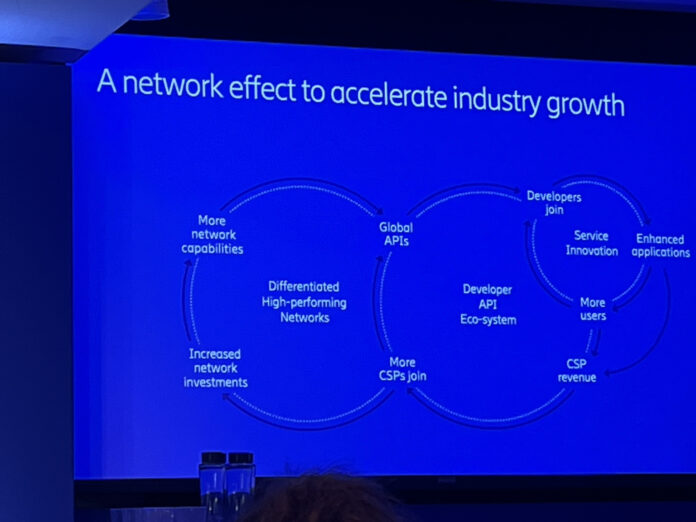The vendor announced new radio products and software, and explained how APIs will save 5G’s bacon
At its annual analyst and press briefing ahead of MWC Ericsson set out its strategy to boost its own fortunes and revive the telecoms industry. In particular it focused on how it intends to enable operators to make money from enterprises and how it is moving to a horizontal platform approach, away from vertical networks based on generations of mobile tech. It sees networks as the foundation layer, with APIs (cloud and device) as enablers at every level.
Clearly buoyed by its perhaps surprising deal with AT&T at the end of last year, which was mentioned frequently, at times a speaker got somewhat carried away. For instance, suggesting that enterprise revenues could be three times those from consumers by 2030. The speaker backtracked when asked for confirmation.
Open-RAN ready radios
On Open RAN, Ericsson launched a range of new radios, which it says are all Open RAN-enabled and supports use of mid-range frequencies. The flagship is the AIR 3255, a Massive MIMO time division duplex (TDD) radio which is more 25% more energy efficient and has 20% lower embodied carbon than previous generations. Meaning greener sourcing of material used to produce it and across the supply chain.
AIR 3255 has a new small metal filter scalable to all TDD sub-6GHz frequency bands to promote 5G mid-band deployment. Ericsson says it is also the first to use the new generation of Massive MIMO Ericsson Silicon (System on a Chip) and uses a single printed circuit board which “is unique to the industry in terms of building practice, as well as passive cooling”.
Johan Hultell Head of Product Line Radio Business Area Networks said that two years ago the focus was on downlink capacity and capabilities because in five years’ time a super strong uplink would be essential.
This big push on the promoting the use of middle band spectrum is interesting in the light of comments when asked why the expected enterprise revenues from 5G and the delivery of services through ecosystems has not materialised.
Erik Ekudden CTO at Ericsson replied that “We were too hopeful when we built the standards. It needs a mid-band network built out in countries and not every country has that.” He also said end-to-end service orchestration is required. In short “We need all those pieces in place and it has not happened yet across enough countries. We don’t think there’s any question of lack of demand for services with SLAs.”
Indeed differentiated connectivity backed by SLAs, slicing, the combination of hardware and software and the perhaps most of all, the critical importance of APIs were the recurring themes.
It is putting a huge amount of faith in open APIs to create ecosystems and monetise 5G, which is not surprising given how much it paid for Vonage.
Ericsson also announced new software. The Service Orchestration and Assurance stack is to enable network operators to orchestrate and manage services across multivendor network domains in hybrid IT environments. The plan is, according to the press statement, that it “works across network generations to efficiently coordinate service creation and management.”
The Dynamic Network Slicing solution is based on Ericsson’s Service Orchestration and Assurance system.
APIs top the agenda
The new CEO of Vonage, Niklas Heuveldop, and guest speaker Peter Arbitter, SVP Magenta API Cap Exposure at Deutsche Telekom (DT), acknowledged at the moment progress towards its API vision were baby steps, but the message is “you have to start somewhere”. There was much talk of CAMARA and signs of inflexion points, network effects (see slide above from event yesterday) and setting the flywheel in motion.
It points to partnerships and rising interest in the market as signs of the unstoppable momentum that is building. For instance, last November, DT announced it would charge developers and business customers for the use of APIs on its mobile network in Germany using the Vonage platform.
Yesterday Ericsson announced a global first-to-market service intended to accelerate developer access to Network APIs via the Vonage Network Registry. The idea is operators make their APIs available via the platform and developers can access them within minutes. The thinking as well as accelerating and simplifying access, it will also scale APIs’ consumption by standardising the approvals process.
This will be on show at MWC including the embedded Silent Authentication within Vonage Verify.
Speakers acknowledged the struggles faced by many Communications Platform as a Service (CPaaS) providers but thinks it will avoid the pitfalls with features such as security products and the SIM Swap Network API, which is in the pipeline,
This allows developers to find out if a phone number has undergone a recent SIM card change and whether it involved fraudulent activity, to create trust and protect voice and SMS services. CAMARA-based APIs, such as Verify Location and Device Status will also be incorporated.
Ericsson also pointed to its collaboration with large scale players, for example, it announced it is to develop a global platform to expose network APIs to developers with Amazon Web Services (AWS).
Niklas Heuveldop, Vonage CEO and Head of Business Area Global Communications Platform, Ericsson, says: “By working with AWS, we will accelerate our ability to embed communications and network APIs in applications and deliver new product offerings for AWS and Vonage customers.”
He adds, “With network APIs, we are exposing new capabilities from within the 5G network that have never been available before, allowing existing applications to be enhanced with network information and enabling the development of a new class of applications.”



